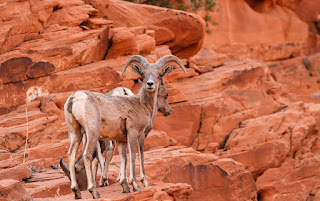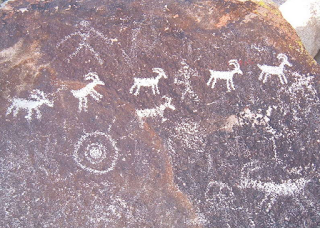Hiking and Enjoying Nevada's Big Horn.
The Bighorn Sheep (Ovis canadensis) is native to North America and
named for its large horns. These horns can weigh up to 30 lbs, while the sheep themselves weigh up to 300 lbs. Males (called Rams) typically weigh about 100 lbs more then the females (called Ewes).

They range in color from light brown to grayish or dark, chocolate brown, with a white rump and lining on the backs of all four legs. Males have scull adaptions which allow for less damage with head impacts.
The desert bighorn sheep subspecies (which are found locally in
Red Rock Canyon and Valley of Fire) are indigenous to the hot desert ecosystems. Bighorn sheep generally inhabit alpine meadows, grassy mountain slopes, and foothill country near rugged, rocky cliffs and bluffs.
Bighorn sheep are susceptible to diseases carried by domestic sheep, such as scabies and pneumonia; additional mortality occurs as a result of accidents involving rock falls or falling off cliffs (a hazard of living in steep, rugged terrain). Bighorns are well adapted to climbing steep terrain, where they seek cover from predators. Predation primarily occurs with lambs, which are hunted by coyotes, bobcats, lynxes, bears, wolves, cougars, golden eagles, and hunters.
Bighorn sheep eat grasses and browse shrubs, particularly in fall and winter. Females tend to forage and walk, possibly to avoid predators and protect lambs, while males tend to eat and then rest, which lends to more effective digestion and greater increase in body size.
Bighorn sheep live in large herds, and do not typically follow a single leader ram. Prior to the mating season or "rut", the rams attempt to establish a dominance hierarchy to determine access to ewes for mating. Bighorn sheep exhibit agonistic behavior: two competitors walk away from each other and then turn to face each other before jumping and lunging into headbutts. Rams' horns can frequently exhibit damage from repeated clashes. Females exhibit a stable, nonlinear hierarchy that correlates with age. Females may fight for high social status when they are integrated into the hierarchy at one to two years of age.
Bighorn ewes have a six-month gestation. In temperate climates, the peak of the rut occurs in November with one, or rarely two, lambs being born in May. Most births occur in the first two weeks of the lambing period. Lambs born earlier in the season are more likely to survive than lambs born later. Newborn lambs weigh from 8 to 10 lbs and can walk within hours. The lambs are then weaned when they reach four to six months old. The lifespan of rams is typically 9–12 years, and 10–14 years for ewes.
 The Anasazi and Paiute Indian used the Big Horn for food, clothes and tools. They would often send small parties of men into the Red Rock Canyon and Valley of Fire areas to search and hunt down the wonderful animal. There are many early signs of these 4-5 men expeditions.
The Anasazi and Paiute Indian used the Big Horn for food, clothes and tools. They would often send small parties of men into the Red Rock Canyon and Valley of Fire areas to search and hunt down the wonderful animal. There are many early signs of these 4-5 men expeditions.
Two hundred years ago, bighorn sheep were widespread throughout the western US, Canada, and northern Mexico. Some estimates placed their population at over 2 million. By around 1900, hunting, competition from ranching, and diseases had decreased the population to several thousand. A program of reintroductions, natural parks, and reduced hunting, together with a decrease in domesticated sheep near the end of World War II
, allowed the bighorn sheep to make a comeback in the Nevada Canyons.
Las Vegas Hiking Adventures
702-274-5150
e mail: leasvegashikingadventures@yahoo.com
Las Vegas, NV.
For more information visit http://www.ndow.org/Species/Furbearer/Desert_Bighorn_Sheep/
For a HIKE and chance to see one in person visit us at lasvegashikingadventures.com

 White Dome - Is located at the end of the scenic drive and is not to be missed. The one mile loop takes you through a three story Narrow and passes an actual Movie set! Beware that there is some steep ups and down on this trail and may not be suitable for older or injured hikers.
White Dome - Is located at the end of the scenic drive and is not to be missed. The one mile loop takes you through a three story Narrow and passes an actual Movie set! Beware that there is some steep ups and down on this trail and may not be suitable for older or injured hikers. 






